As law enforcement agencies further wade into the realm of the digital world, engaging and encouraging conversation in a limitless forum, the duties to respond, interact, and follow up with queries and communication fall almost entirely into the hands of an agency’s public information officer.
The belief that one person or one team can home in on the voice and tone of an agency is strategically crucial. The trust and support from the command staff to empower an individual to speak on behalf of an agency is vital not only from a leadership perspective, but also for the person tasked with this undertaking.
Every day, for every person an officer on the street may encounter, that number could easily be multiplied for public information officers in online space. Their digital audience goes well beyond the in-person interactions, with potentially thousands of people looking on as an agency responds to ongoing conversations in threads on sites including Facebook, Twitter, or Nextdoor. Nearly 95 percent of U.S. adults use smartphones, for example, giving access to an agency’s news right at their fingertips.1 To add, roughly 90 percent of U.S. adults use the Internet, meaning that an agency is highly likely to have its story told first in a digital space, where word—and opinions and judgments—spreads incredibly quickly.2
But beyond being a communications champion, public information officers are so much more. They bear an agency’s communicative responsibilities in a multitude of ways, which makes them some of the most adept people on the planet. They are masters of all, honing skills in multiple fields, compared to most professionals who achieve mastery in only one or two. People interact with private sector companies in a digital space regularly, and as such, they establish expectations that the level of customer service should be the same with the public sector; essentially, law enforcement, a customer service profession, will inevitably be compared against the experiences people have with private sector companies. Therefore, every skill is another step toward balancing the scales for helping others hear and understand the work and the story of a law enforcement agency.
Digital Risk Manager
As a public information officer is tasked with helming the online communication channels for an agency, it is imperative that an agency fills the role with someone who has expertise in messaging and responsiveness during crises. Details, recaps, and more must be carefully thought out and easy for a reader to digest. This is not necessarily a skill that is easily obtained, with emotions coming in to play in moments where fear and uncertainty can overwhelm the dissemination of facts.
A public information officer who is a digital native, who can assess tone and predict nuances in text alone, will excel where many others would fail. These individuals are digital risk managers—they serve as the conduit between an agency and the public while simultaneously allowing agency personnel to do their jobs effectively by stepping up to answer the incoming deluge of inquiries from the public.
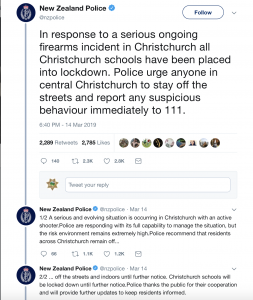 Agencies across the globe have public information officers and social media managers who are handling tasks under fire with incredible grace and authority. The New Zealand Police social media team, for example, displayed incredible resolve as the horrors of the Christchurch attack unfolded in March 2019. In a rapid succession of tweets, the agency quickly and effectively shared information while the incident tragically unfolded, providing much needed updates that helped inform the public—and the rest of the watching world—about what was happening and what officers were seeing in real time.3 The agency had empowered its public information officers to be able to share this information, rather than wait to gather intel and let others tell the story in a time when everyone really needed to hear updates from one place—the police.
Agencies across the globe have public information officers and social media managers who are handling tasks under fire with incredible grace and authority. The New Zealand Police social media team, for example, displayed incredible resolve as the horrors of the Christchurch attack unfolded in March 2019. In a rapid succession of tweets, the agency quickly and effectively shared information while the incident tragically unfolded, providing much needed updates that helped inform the public—and the rest of the watching world—about what was happening and what officers were seeing in real time.3 The agency had empowered its public information officers to be able to share this information, rather than wait to gather intel and let others tell the story in a time when everyone really needed to hear updates from one place—the police.
This type of effective communication has been seen before—just take a look at the Jacksonville, Florida, Sheriff’s Office Twitter account. As the Jacksonville Landing Mass Shooting unfolded during a live-streamed video game tournament, the public information officer took total control of the process of disseminating information.4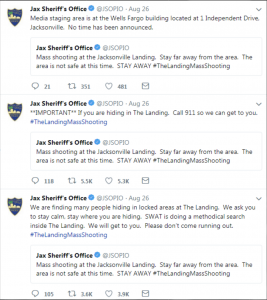
The public information officer repeatedly and effectively acted as if each statement sent out on social media was a shortened version of a press release, creating a stream of critical pieces of information for public consumption. This rerouted many who would have otherwise waited to hear from third-party sources to get updates on what they had watched unfold in real time, ensuring the sheriff’s office was the primary source of information and cultivating a sense of timeliness and transparency along with quashing any potential upticks in the rumor mills.
In these moments, it cannot be stressed enough that those who wield the power to share information should be those who understand how to navigate digital channels and speak on behalf of an agency in a way that conveys authority as well as empathy and community. Those who become the digital point of contact for the public in a crisis help assuage concerns; share helpful tips or insights; and keep trolls, bullies, or those who lack understanding at bay. They also become the one person that thousands, and potentially millions, of people online entrust to be readily available to answer questions and provide updates in ways that not only reflect the “online personality” that followers and residents have come to know, but does so in a way that feels authentic and effective.
Graphic Designer
Public information officers are often tasked with coming up with campaigns, public safety announcements, and more to help educate and provide outreach to the public, developing ways to help them better consume what can be labeled boring or bland in ways that are visually stimulating. Years of skills building and training are often what define the career of a graphic designer, but social media managers and public information officers have to learn how to emulate those skills in much less time while still having an important impact on agency messaging.
Public information officers understand that branding and marketing must reflect the professional image an agency wishes to convey. They can quickly create content that stays on brand—aligning with coloring, patches, and badges—while also being eye-catching and shareable with the public. They understand how to incorporate just the right amount of information so that the graphic, chart, poster, or other public resource is consumable for all ages. They understand that content can change, but the overall presentation and product must highlight the values and mission of the agency in a way that is professional and polished.
What does that look like? Two examples from different agencies during different incidents showcase how effective a public information officer is at curating content in a graphically enhanced way that not only is visually captivating, but also is a defining establishment for what the public can expect to see from the agency.
 Take a look at the Campbell Police Department tax scam graphic. The safety message they are conveying is clear and concise. The graphic includes logo branding, and it gets the point across efficiently and effectively. Viewers will know immediately where they may expect to see scam calls, and, hopefully, understand they should not answer from numbers they do not know.
Take a look at the Campbell Police Department tax scam graphic. The safety message they are conveying is clear and concise. The graphic includes logo branding, and it gets the point across efficiently and effectively. Viewers will know immediately where they may expect to see scam calls, and, hopefully, understand they should not answer from numbers they do not know.
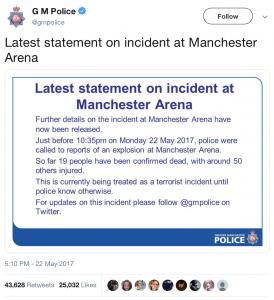 The Greater Manchester Police in the United Kingdom offer another graphic option. During the Manchester bombing in May 2017, they created graphics to quickly summarize key details of the incident in one place so that others did not need to scroll through their Twitter feed or read through a Twitter thread to cull information on what had occurred. They also ensured their name and logo were easily noticeable on the graphic so that there could be no mistake that the information was coming from their agency, and that, should the graphic be shared by news outlets and others, people would be able to readily tell it originated with the police.
The Greater Manchester Police in the United Kingdom offer another graphic option. During the Manchester bombing in May 2017, they created graphics to quickly summarize key details of the incident in one place so that others did not need to scroll through their Twitter feed or read through a Twitter thread to cull information on what had occurred. They also ensured their name and logo were easily noticeable on the graphic so that there could be no mistake that the information was coming from their agency, and that, should the graphic be shared by news outlets and others, people would be able to readily tell it originated with the police.
Audio/Visual Coordinator
It is said a picture is worth a thousand words. If that’s the case, then videos are worth a million. No one knows that more than a public information officer.
In today’s fast-paced news cycle, eye-grabbing headlines, and short attention spans, law enforcement agencies have once again been shoved up against the ever-changing tide of information sharing strategies. Not a decade ago, social media was the new phase of information dissemination to the public and the press. But now, it’s not just about being “on” social media—agencies must ask themselves what kind of content on social media they can champion to help communities better connect, engage, and educate.
Nothing captures the imagination—or the public’s attention—more than visually captivating content. Public attention is a precious commodity, given that the human attention span, according to research, has dropped to just over eight seconds.5 The responsibility—and the skills—to share an agency’s story and take control of its narrative are often held by the public information officer. While some agencies are fortunate enough to have a team that can help build visual content, a vast majority of the time, that duty falls to one or two people. Public information officers know that, in a society where instant gratification is the greatest currency, where “see to believe” is the ultimate transparency tool, footage and video pulls the curtain back on policing, a job typically defined by the news or television shows in the past.
Public information officers must know how to wield the tools necessary to help build and brand an agency’s story. They must know how and when to tap into the narrative vein, combining visual content with descriptive analysis to either provide insight on an investigative process or to provide a voice in a critical incident when others would show or tell a half-truth. Above all, they work to ensure that every angle is covered, much like journalists, so that no questions are left on the narrative table. Public information officers must bring a team to together to help others know that, while videos may show a story, the agency can have internal subject matter experts on hand to provide as much detail as possible on what an audience is viewing on their screens. This requires expertise and knowledge of video editing software, captioning techniques, and incident breakdowns, all in the name of ensuring that the agency remains a trusted source throughout the process.
When the Mountain View, California, Police Department was involved in the investigation regarding what potentially led up to the YouTube shooting in April 2018 in San Bruno, California, body camera footage provided a critical missing piece in the narrative of what the world assumed to be true. People were not only looking to understand why this incident occurred; they were looking to see if it could have been prevented. With the news that the Mountain View Police Department had encountered the female shooter the night before sleeping in her vehicle in their city, many—including news outlets—pointed a finger at the agency. They wanted to see, not hear, what could have led police to let the woman stay in the area after encountering her.
A press release describing the interaction wasn’t enough. People needed to see to believe what they were being told. As such, Mountain View police released nearly 40 minutes of body-camera footage, with every moment captioned so that there could be no question of what viewers were hearing and seeing. The “what-ifs,” the hypotheticals, the criticism, and the lingering questions all immediately stopped. Instead, the public got to see for themselves how a routine call unfolds and how and why questions are asked, and they were also provided a detailed synopsis of all processes and protocols in a press release that accompanied the video.6
Customer Service Captain
Jeff Bezos, CEO of Amazon, was once quoted as saying, “If you make customers unhappy in the physical world, they might each tell six friends. If you make customers unhappy on the Internet, they can each tell 6,000 friends.”7
With online accessibility to any organization—private or public—the expediency needed to ensure a community stays satisfactorily informed has risen dramatically as social media continues to allow for people to quickly connect to everyone and anyone. Public information officers must understand that every conversation, every question or concern, matters. They know that when their communities are looking for answers, they should be able to get answers from their local law enforcement agencies. Even more so public information officers know that each response should be provided with courtesy and kindness.
This two-way engagement opportunity is the most granular way to immerse a growing digital followership into an agency’s brand (remember, a public information officer must always work to ensure the integrity of an agency). This opportunity safeguards residents’ needs, and once again establishes that when a crisis strikes, digital communities (which can often include a city’s own residents) know in no uncertain terms that they can access an agency to quickly get the answers they need and, as a byproduct, feel safe and informed.
Law enforcement agencies must empower their public information officers, who are, in essence, their chief marketing officers, to be able to quickly and efficiently respond to “customers” across their social media platforms to develop and grow an agency’s reputation, making it more communicative and transparent. Much like what Bezos mentioned, an agency will have only so much power to be able to convince others that they are present and that they are there to engage. A community and its residents are the true litmus test for how an agency is doing in its customer service care in a digital space.
Social Media Guru
In all the efforts a public information officer embarks on to ensure that an agency stays relevant and at the forefront of communication efforts in a digital age, it goes without question that adaptability to new trends is a must.
Public information officers across the world are finding new and innovative ways to either use new aspects of social media or utilize improved facets of current apps and sites so as to enhance the way in which agencies connect, converse, and create digital communities. For example, public information officers in Evansville, Indiana, have entered a space that many shy away from because it is too new; too different; and, potentially, too lax for an agency when it comes to falling in line with branding efforts. Evansville police have become masters of Snapchat and, in doing so, have created an entirely fresh way of engaging the growing number of people in their community and beyond who use that platform.
Snapchat, on average, is utilized by younger audiences, but according to the platform, one in three people who now use Snapchat are parents.8 While data show that Snapchat is still a solid platform to connect with teens and young adults, it would be a mistake to assume that the platform would be a wasted outreach effort for other audiences as well.
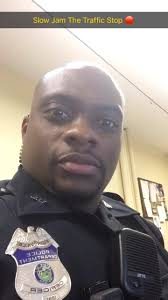 Evansville public information officers have mastered the way in which they connect with their community audiences, allowing a new generation within the digital community get to know law enforcement personnel in a space in which the users prefer to communicate. They get to see, hear, and learn from the officers about traffic safety (through their beloved “Slow Jam Traffic” routine) and about the officers’ daily jobs, and they get to have a fun, interactive experience that might not otherwise exist if users were forced to have conversations elsewhere. They have taken a platform many would have assumed is “for kids” and created a conversation space where viewers see relatable people in an occupation in a way that can be fun, humorous, and educational.
Evansville public information officers have mastered the way in which they connect with their community audiences, allowing a new generation within the digital community get to know law enforcement personnel in a space in which the users prefer to communicate. They get to see, hear, and learn from the officers about traffic safety (through their beloved “Slow Jam Traffic” routine) and about the officers’ daily jobs, and they get to have a fun, interactive experience that might not otherwise exist if users were forced to have conversations elsewhere. They have taken a platform many would have assumed is “for kids” and created a conversation space where viewers see relatable people in an occupation in a way that can be fun, humorous, and educational.
With a free, creative outlet to educate and inform all ages and audiences, why not try it?
The same innovative mind-set has led the New York Police Department (NYPD) social media manager and the department’s public information officer team to pivot on how they use Instagram to better connect with the department’s online community. Rather than just posting photos of the goings-on within the department, the NYPD social media team has quickly and effectively adapted to using Instagram Stories to connect and tell stories about their agency.
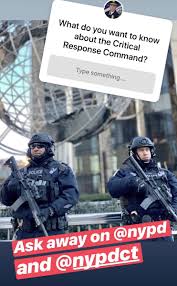 That change could not have come at a better time. According to a recent article on Social Media Today, on average, 500 million people per day are using Instagram Stories.9 By adapting to prioritize the use of a particular feature in a platform that half a billion people prefer to use daily, NYPD is heightening its potential for awareness within the Instagram community. Rather than just building the agency’s stories through photos on its Instagram profile, the NYPD public information officers are actively learning and adapting to how people want to communicate today and tomorrow, and they are willing to test out those features to see what will be the next best thing to connect their agency with their communities.
That change could not have come at a better time. According to a recent article on Social Media Today, on average, 500 million people per day are using Instagram Stories.9 By adapting to prioritize the use of a particular feature in a platform that half a billion people prefer to use daily, NYPD is heightening its potential for awareness within the Instagram community. Rather than just building the agency’s stories through photos on its Instagram profile, the NYPD public information officers are actively learning and adapting to how people want to communicate today and tomorrow, and they are willing to test out those features to see what will be the next best thing to connect their agency with their communities.
Ever-Changing Efforts
Each new step and each new process a public information officer undertakes to enhance communication efforts for an agency is a monumental task. It is a daily reminder that social media and where communities prefer to connect in a digital space, must be a priority that public information officers are equipped to handle. The public information officers of today believe in the power of a Tweet, they understand the return on investment for every message posted, and they know that to rise above much of the noise that exists on social media, they have to stay fresh, relevant, and relatable.
These traits for the modern-day public information officer will continue to revolutionize the way in which law enforcement agencies are telling their stories and sharing information with communities near and far. Even more so, these strengths will become the bedrock for communication strategies for law enforcement agencies in the 21st century.
Notes:
1 Paul Hitlin, “Internet, Social Media Use and Device Ownership in U.S. Have Plateaued after Years of Growth,” Fact Tank, September 28, 2018.
2 Hitlin, “Internet, Social Media Use and Device Ownership in U.S. Have Plateaued after Years of Growth.”
3 New Zealand Police, Twitter post, March 14, 2019, 6:40 p.m.
4 JAX Sheriff’s Office [Jacksonville, FL], Twitter post, August 26, 2018, 11:13 a.m.
5 Cision, “Are Declining Attention Spans Killing Your Content Marketing Strategy?” January 22, 2018.
6 City of Mountain View, “MVPD Releases Officer Worn Camera Footage in Nasim Aghdam Interaction,” Mountain View City News, April 13, 2018.
7 Daniel Newman, “Customer Experience Is the Future of Marketing,” Forbes, October 13, 2015.
8 Monicac Anderson and Jingjing Jiang, Teens, Social Media & Technology (Washington, DC: Pew Research Center, 2018); Sofia Gross, “Snapchat: Get on Board & Learn Top Techniques” (GSMCON 2018, Denver CO, April 24, 2018).
9 Andrew Hutchinson, “Instagram Stories Is Now Being Used by 500 Million People Daily,” Social Media Today, January 31, 2019.



